How to Play 3 Card Poker: The Ultimate Guide
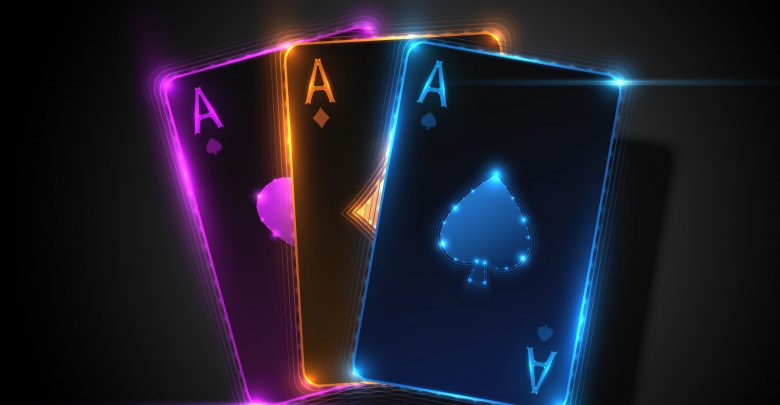
Three card poker is both a live and online casino table game constructed on the foundations of poker with the speed of a traditional table game.
Based on the traditional 16th-century British card game “Three-card brag”, three card poker is surprisingly one of the newest table games to become widely adopted by casinos.
A brief history of 3 card poker
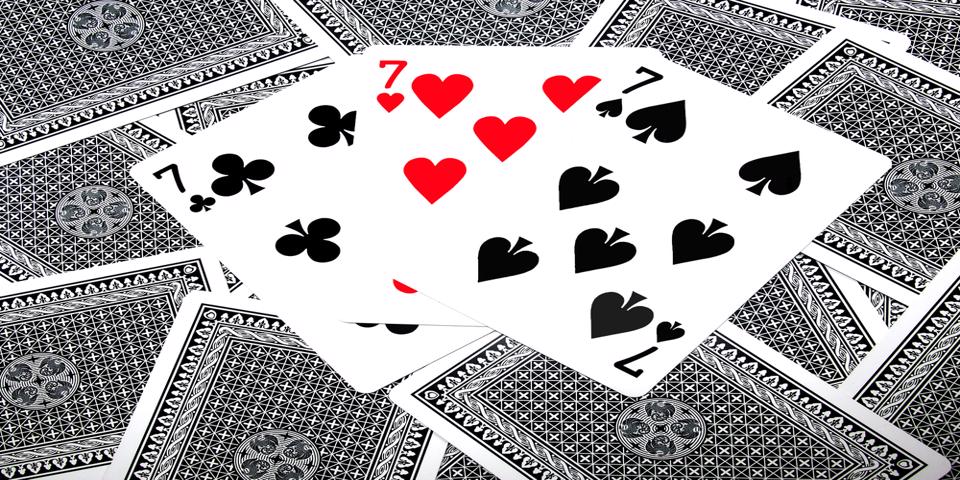
As far as casino games go, 3 card poker is one of the newest available that you’ll find on any gaming floor.
Created in 1994 and patented in 1997 by Derek Webb of the United Kingdom, 3 card poker took the casino world by storm combining the charm and skill of poker with the speed and excitement of other table games. Webb, the creator of the new game, focused his interest into three main areas to ensure the game contained the right ingredients:
- The rules had to be easy to understand and pick up
- The payouts had to be large enough to attract players
- The house edge had to be large enough to gain interest from the casinos
Originally, Webb set out to market his created game in both the UK and the US, but after talking with The British Casino Association (now known as the National Casino Industry Forum), he was told to first gain experience in the US market first.
Due to the tight regulations in the UK, Webb found that the UK would not support such a table game and his application was not strong enough to make the necessary regulatory changes for a new game of this caliber. As the US regulations allowed the game to launch, it wasn’t long before it was picked up by no other than Barry Morris.
Morris, the Vice president of Grand Casino Gulfport in Mississippi, found promise in Webb’s proposal, despite the previous misfortune in casinos in Las Vegas, Reno, and Atlantic City and, with Webb’s promise to train the dealers himself, a deal was made.
In part thanks to the progress made in the US, the UK’s gambling regulations changed in 2002, permitting 3 card poker entering the country.
Three card poker hand ranks
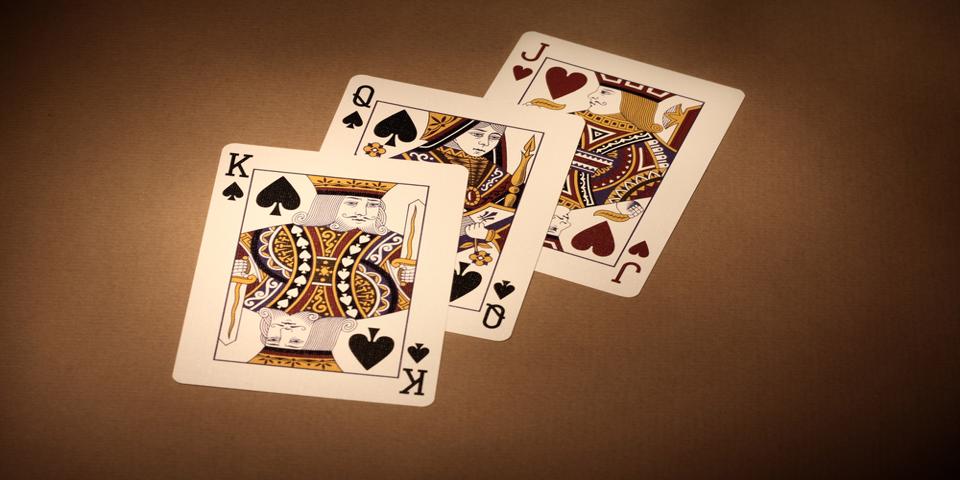
The hands that players build in poker is both the first thing you should learn and one of the most common sticking points for new players, but when it comes to three card poker, there’s yet another level of confusion for gamers to face.
The typical Royal Flush to High Card doesn’t stand in the game and although there are similarities, small differences can catch out beginners. For starters, the best hand that can be achieved in the three-card game is not a royal flush (you won’t typicaly find that hand in the game although some casinos offer a “mini-royal”), but rather the straight flush.
A full list of the available hands (featuring examples, frequency, and probability) can be seen below:
| Rank | Description | Example | Frequency | Probability |
| Straight flush | Three suited cards in sequence | J-10-9 | 48 | 0.22% |
| Three of a kind | Three cards of the same rank | 6-6-6 | 52 | 0.24% |
| Straight | Three cards in sequence | 9-8-7 | 720 | 3.26% |
| Flush | Three suited cards | Q-10-6 | 1,096 | 4.96% |
| Pair | Two cards of the same rank | 2-2-Q | 3,744 | 16.94% |
| High card | None of the above | A-J-10 | 16,440 | 74.39% |
| Total hands | – | – | 22,100 | – |
Table: The ranked hands in 3 card poker including examples, frequency, and the probability of each hand
Eagle-eyed readers will have no doubt noticed that the straight is actually ranked higher than the flush when playing 3 card poker (the opposite is true in Texas Hold’Em) and that’s no accident. When playing with the three cards, the probability of the straight is less than the flush, naturally resulting in a higher-valued hand.
However, not all casinos offer the same pay table and some will offer the mini-royal, catapulting to the very top of the hand list. A mini-royal is, as you’d expect, the rarest hand that can be built in 3 card poker, consisting of A-K-Q in any suit.
How to play 3 card poker

3 card poker is played as a heads-up game between the player’s hand and the dealer’s hand, differing from 3 card brag which is played player-to-player.
The game has two main basic ways to play in the “Ante-play” and “Pair Plus” options, although side bets do exist in some casinos. Players are able to choose whether they would like to play Ante-play, Pair Plus or both when they begin a hand.
Ante-play
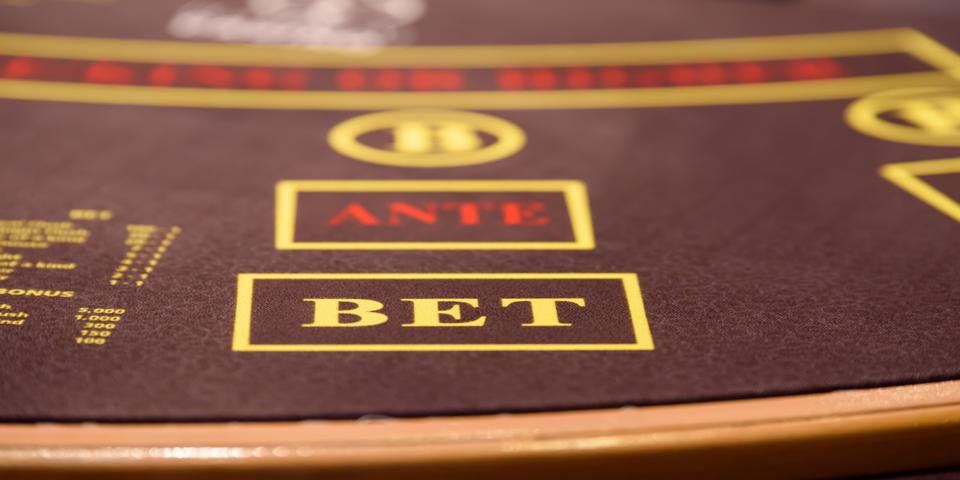
Ante-play begins with an ante wager from all players before receiving their cards.
This is somewhat similar to the way in which Texas Hold’Em will include both a big and small blind depending on the seating position (moving clockwise) but isn’t for pot-value.
Once all ante wagers (and Pair Plus wagers) are placed, three cards are dealt to each of the players around the table as well as three to the dealer. Players are then given the options to either fold, continue in the hand with a “play” wager equal to that of the ante. Once all players have decided on an option, the hands are exposed and the wagers resolved.
In order for the dealer to play their hand, they must hold a Queen high or better.
If the dealer does not play, there is no action and all wagers will be repaid 1 to 1. However, if the dealer does play, the dealers and player’s hands are compared as the “showdown”. If a player hand loses, the player will lose both their “ante” and “play” wagers simultaneously. However, if the player hand wins, both the ante and play wagers will be paid 1 to 1.
If the hands showed are tied, there is no action on either wager. It’s important to note that each player is playing against the dealer, not against fellow players.
Ante-play strategy

Unlike blackjack or a traditional poker game, there’s not a huge amount of strategy that goes along with optimal 3 card poker play.
Instead, the basic strategy for the ante-play involves betting whenever the player’s hand consists of a Q-6-4 or better, folding if their hand ranks any lower. What this means, in a nutshell, is that if you’ve managed to get anything showing a pair or better, you should bet – basically, if it’s a winner on the Pair Plus paytable, make the bet in the ante-play combination.
If a player’s hand isn’t showing a pair or better, it’s best from them to make the play bet whenever they’re seeing a high card of an Ace or King, regardless of the other two cards in the hand. Similarly, if the high card lands on a Jack or lower, it’s best to fold, regardless of how high the other two cards may be.
In the case of a Queen high card, judgment will often fall to the second and third high cards. If you’re looking at a 6-4 (or equivalent) or higher, it’s best to bet. In summary, use the following cheat sheet:
- Always bet on a Queen-high hand when the second-highest card is a 7 or larger, regardless the third card
- Always bet on a Queen-high hand when the second-highest card is a 6 only when the third card is a 4 or a 5
- Always fold a Queen-high hand when the second-highest card is a 6 when the third card is a 2 or a 3
- Always fold a Queen-high hand when the second-highest card is a 5, regardless of the third card.
The Ante Bonus
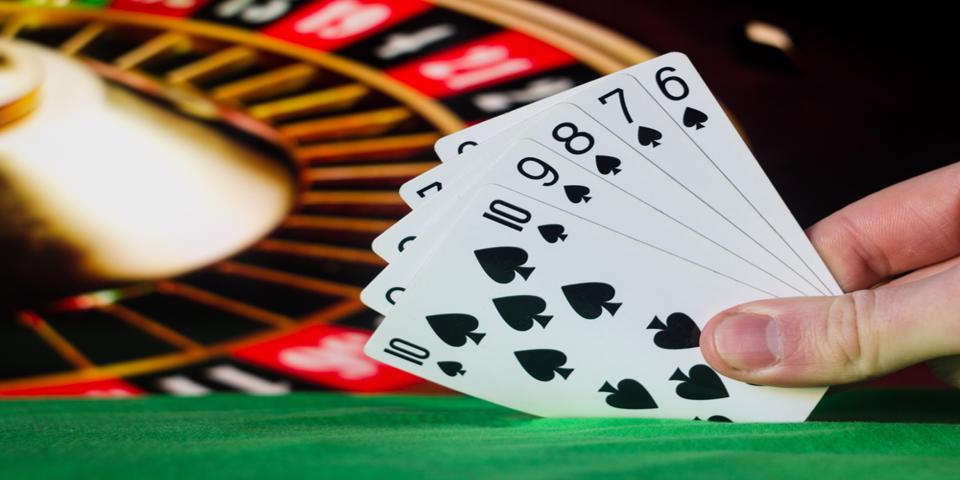
An additional bet which can be offered by casinos is the “Ante Bonus”, paid on the ante wager for hands landing a straight or better.
Like the Pair Plus bet (more on this later), the Ante Bonus is available regardless of the dealer’s hand, the two are mutually exclusive. Typically, these will be paid as a 5 to 1 for a straight, 4 to 1 for a three of a kind and 1 to 1 for a straight.
A table of the common pay tables for the ante bonus and combined overall ante-play combination can be seen.
| Hand | A | B | C |
| Straight flush | 5 | 4 | 3 |
| Three of a kind | 4 | 3 | 2 |
| Straight | 1 | 1 | 1 |
| House edge as a percentage of ante | 3.37% | 3.83% | 4.28% |
| House edge as a percentage of ante-bet total | 2.01% | 2.28% | 5.26% |
Table: The Ante Bonus and overall house edge for the ante-play combination
Players will find that paytable “A” with the 5-4-1 payoffs is the best and with the lowest house edge, it’s hardly a surprise.
The house edge that we see in this table tells us two different things about the game that are worth noting before choosing to play. First off, when the house edge is viewed as a percentage of the ante, it gives the baseline for the average losses players should expect to see.
If players are constantly wagering $5 per hand, for example, losses would sit at around 17 cents per hand. In a game in which 100 hands are played with the constant $5 antes, players should expect an average loss of approximately $17 when using a Q-6-4 system.
It’s not exactly awe-inspiring, but anything can happen during the game. Plus, with a 2% house edge, it puts 3 card poker into a better position of odds than roulette, craps and Caribbean Stud among many other games.
Pair Plus
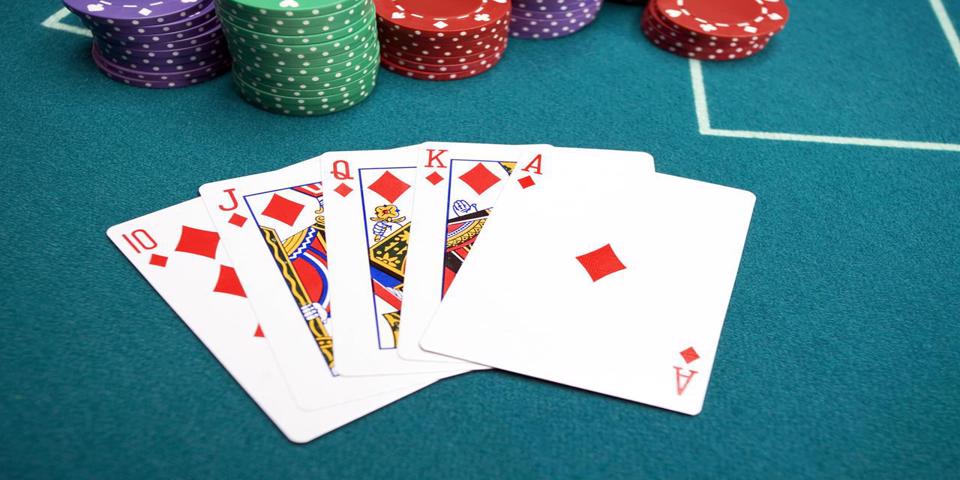
The second way to play is with the “Pair Plus” wager, forming a bet stating that the player’s hand will be a pair or better and will win if the player has at least a pair of twos.
To make a Pair Plus bet, players are simply required to place their wager on the Pair Plus circle on the table before the cards are dealt (at the same time as the Ante). Players won’t have to do anything else at this point, they’re strapped in for the ride.
Once the cards are dealt, players will instantly see what their hand consists of and whether or not their bet has paid off. The payoff will stand true regardless of the dealer’s hand as the two are mutually exclusive. A table of frequency of paying hands in Pair Plus can be seen below:
| Paying hand | Frequency |
| Mini-royal | 1 in 5,525 |
| Straight flush in-game with mini-royal | 1 in 502 |
| Straight flush in-game without mini-royal | 1 in 460 |
| Three of a kind | 1 in 425 |
| Straight | 1 in 31 |
| Flush | 1 in 20 |
| Pair | 1 in 6 |
Table: Frequency of paying hands in Pair Plus
Players are unlikely to bet on outcomes with such small probabilities without high payouts and with the Pair Plus bet, that’s exactly what they’ll see. For players dealt a straight flush, they can usually expect to see a 40-1 payoff while three of a kind brings 30-1, big numbers that start to make the bet worth it.
You can see a sampling on just some of the available pay tables and associated house edges present today below:
| Hand | A | B | C | D | E | F |
| Mini-royal | 100-1 | 50-1 | 50-1 | – | – | – |
| Straight flush | 40-1 | 40-1 | 40-1 | 40-1 | 40-1 | 35-1 |
| Three of a kind | 30-1 | 30-1 | 30-1 | 30-1 | 30-1 | 25-1 |
| Straight | 5-1 | 5-1 | 6-1 | 6-1 | 5-1 | 6-1 |
| Flush | 4-1 | 4-1 | 3-1 | 3-1 | 4-1 | 4-1 |
| Pair | 1-1 | 1-1 | 1-1 | 1-1 | 1-1 | 1-1 |
| House edge | 4.49% | 5.39% | 7.10% | 7.28% | 5.57% | 4.58% |
Table: A sample of just some available paytables and associated house edges
It’ll come as very little surprise that the majority of live casinos opt for the highest house edge in paytable ‘D’, although it’s not uncommon to find one of the others in your local establishment.
Online casinos will differ somewhat and, due to higher levels of competition, will generally offer a lower house edge than the live casino equivalents. That means you’re much more likely to see paytables ‘A’, ‘B’ and ‘F’ when playing online and ‘C’, ‘D’ and sometimes ‘E’ when in a live venue.
Pair Plus strategy

It won’t come as much of a surprise to find out that there’s little-to-no strategy involved in wagering in the Pair Plus method of play, instead, it’s all about picking the right game.
As seen in the table above, it pays to find the best paytable available in the casino, whether live or online, to minimize the house edge while playing. Of course, online play will be your best bet when looking for a lower house edge, but that doesn’t mean that some live casinos won’t offer a fair paytable.
The ante-play and ante-bonus will get the biggest bang for your buck when playing 3 card poker, but if players are looking to wager for the chance of larger prizes, it’s the Pair Plus bet that should be made.
To cut a long story short
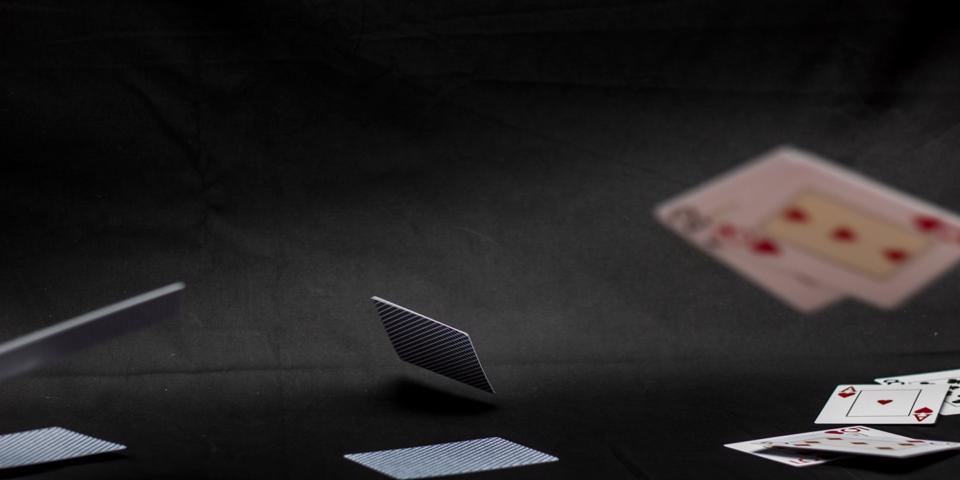
That’s it – everything you need to know about 3 card poker, how to play and what the best strategies are for the two forms of play, but if you manage to read it all – here’s all you need in a short cheat sheet form.
Three card poker is played heads up and has two methods of wagering in Ante-Play and Pair Plus.
In Ante-Play, before the cards are dealt an ante wager is made. Players then have the chance to fold or make a “play” bet equal to that of the ante if they would like to continue. If their hand is better than the dealers, they will win, doubling their wager (ante+play). If the player’s hand is weaker than the dealers, they will lose their wager (ante+play). If the hands are equal, the wager will be repaid 1 to 1.
An ante bonus wager may also be available, giving the option for players to wager on a straight or better with payouts varying from casino to casino. This bet is mutually exclusive to the typical ante-play.
In Pair Plus, players will wager at the same time as the ante on the Pair Plus circle. This wager is the bet on whether the player’s hand contains a pair of twos of better (as shown in the hand’s table). Payoffs will depend on the casino, but will usually show 40-1 odds on a straight flush, 30-1 on a three-of-a-kind, etc. The Pair Plus bet is mutually exclusive to the ante play.
Players are able to choose between ante-play, Pair Plus or both for each hand that they play.
Strategy for Ante-Play
- Always bet on a Queen-high hand when the second-highest card is a 7 or larger, regardless the third card
- Always bet on a Queen-high hand when the second-highest card is a 6 only when the third card is a 4 or a 5
- Always fold a Queen-high hand when the second-highest card is a 6 when the third card is a 2 or a 3
- Always fold a Queen-high hand when the second-highest card is a 5, regardless of the third card
Strategy for Pair Plus
- Look for the best pay tables available that minimize the house odds, there’s not a lot else that can be done






